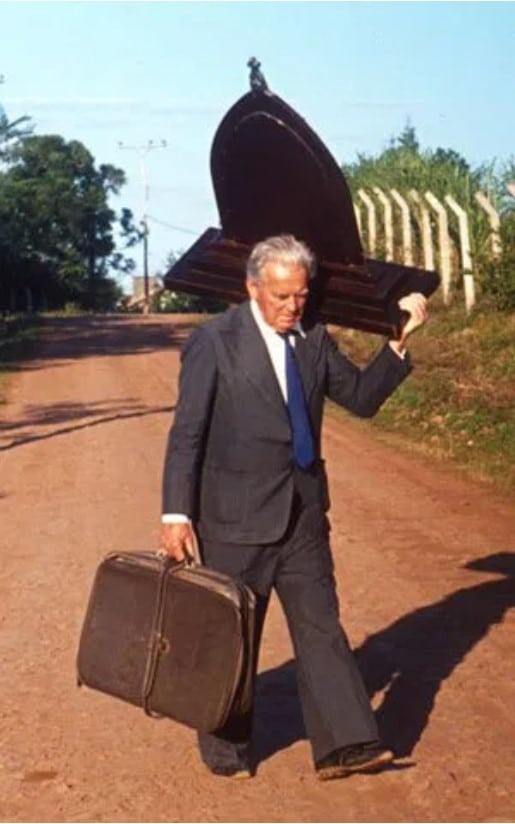With joy and gratitude we share with the International Schoenstatt Family that John Pozzobon’s Pastoral Secretariat in Costa Rica was established in January 2022.
Its main objective is to promote and spread the life and work of the Servant of God John Louis Pozzobon, thus becoming a vital support for his cause of beatification. Through the Secretariat, testimonies, petitions, and prayers of the local faithful that contribute to the cause of his beatification are welcomed.
The process of beatification of the permanent deacon John Louis Pozzobon was opened on December 12, 1994 in the Archdiocese of Santa Maria, Brazil. It was sent to the Holy See in May 2009 and is now in the hands of the Congregation for the Causes of Saints at the Vatican.
John Pozzobon: I felt like a pupil of Father Kentenich
John Louis Pozzobon was born on December 12, 1904 in Ribeirão, district of São João do Polênsine. The son of Italian immigrants, John Pozzobon grew up in a simple and pious family, who prayed the Rosary every night. At the age of 10, he tells his father that he would like to become a priest. So, he begins his studies at the seminary of the Pallottine Fathers in Valle Veneto, not far from his hometown. After about 10 months there, he decided to return home, because his father needed John to help him in the fields. His family was a low-income family. At the age of 14 he began to experience health problems. Although he was a strong man, his eyesight progressively worsened and he was unable to continue his schooling. For the same reason, he is considered ineligible for military service. Years later, John will say about his health: “God, in his infinite goodness, did not consider me incapable. He used me as I am and I entrusted myself to his Mother for the Holy Rosary Campaign. No one is incapable of serving God.”
In 1928 he married Tereza Turcato, with whom he had two children. He was widowed and married Vitória Filipetto in 1933, with whom he had five children. He left his occupation as a farmer to open a small store in front of his house. In 1930 he moved to Santa Maria.
It was in 1947 that his life crossed paths with the Schoenstatt Movement. He participated in a day of spiritual formation, and also in the blessing of the foundation stone of the Schoenstatt Shrine in Santa Maria. Father Joseph Kentenich, founder of Schoenstatt, was present at this ceremony. This event will mark him forever. Later, he would say: “I felt like a student of Father Kentenich”.
John sealed his Covenant of Love with the Blessed Mother on April 11, 1948, the day of the blessing of the Shrine in Santa Maria.
Schoenstatt Pilgrim Mother Campaign: One man can move the world.
In September 1950, John participates, together with around one hundred men, in a series of talks. They talked about the importance of praying the Rosary and how to encourage a prayer crusade in families. On September 10, 1958, three replicas of the image of the Mother Thrice Admirable were blessed in the Shrine, and Sister M. Teresinha entrusted one of them to John: “This image will remain in your care. It is not necessary for you to pray the Rosary every night. You will only have to see to it that she goes on pilgrimage from house to house.”
John writes further on, “When something comes from God, a man can move the world. I told Our Lady: ‘I have seven children and a wife, and I am responsible before God for my children and my wife. But if it is God’s will and yours, a man can move mountains.’ And all went well. In the early years of the Campaign, I devoted two hours a day of my time to the Mother and Queen. When the children were older and able to work in the store, I devoted myself exclusively to the Campaign. If God wants someone to act in a task, he also gives him time to dedicate to his family.”
Popular evangelizing mission

John begins to visit schools, hospitals, and prisons in the region. And always on foot, carrying the image, which weighed 11 kilograms, on his back. He organizes “missions” in the villages: he carries the image of the Virgin and families gather to pray the Rosary. He preaches the Gospel, talks about conversion, asks about the material and spiritual well-being of the families and returns a few days later carrying needed supplies accompanied by a priest to celebrate Mass, to hear confessions, marry couples and baptize children. Thanks to his dedication, many families return to the Church, pilgrimages are organized to the Schoenstatt Shrine, Eucharistic adoration is established in several parishes, chapels are built in the villages.
Eventually, John can no longer make all the visits with the Pilgrim MTA on his own, so the Schoenstatt Sisters of Mary make copies of the Pilgrim MTA, but in a smaller size to make it easier for other volunteers to transport it.
Permanent Deacon
On December 30, 1972, Pozzobon was ordained a permanent deacon in the Chapel of Nossa Senhora das Graças, built by him in 1971. In this Chapel he celebrated baptisms, weddings, and every Thursday he gathered with the community for adoration of the Blessed Sacrament. Nowadays you can find a sign on a pew indicating where the Deacon prayed. The chapel is located at Avenida Osvaldo Cruz, 609, Km 3. Since then, Deacon John Pozzobon was harshly tested. At first, his work is not understood and he is often criticized. But he remains obedient to his bishop and his parish priest.
Commitment to the poorest
John founded the “Noble Village of Charity”, where he built houses for poor families living on the streets: “There I understood the meaning of the Way of the Cross, the affliction of Christ that we can only imagine. The suffering of our brothers caused by those who make no effort to sacrifice themselves for others. I trust in divine Providence. I have never been a rich man, but I know that God does not abandon those who serve their neighbor.”
So Pozzobon and a group of volunteers begin distributing clothes, food and educating the people of the Noble Village of Charity on how to work the land. They plant fruit trees and flowers. Their goal is to help the poor gain dignity and self-confidence.
“I wanted so much to change this world so dominated by materialism. To bring Jesus, to bring his message, so that everyone would become good and love their brothers and sisters. I felt so much strength and joy, and I placed myself at the Mother’s disposal, accepting all the sacrifices she would send me. For love of this sacred image, I have lain in two thousand different beds in the darkness of the night, among the lilies of the fields and the forest. She always accompanied me on long marches, crossing valleys and rivers, and when I sat on the road saying to her: ‘Mother, I can’t go on any further!’ When I went through humiliations and difficulties, She always accompanied me. By my own strength I could never have done all this”.
The last pilgrimage
On June 15, 1985, at the Shrine, John offered his life for the growth of the Rosary Campaign. On the morning of June 27, 1985, he was walking along the side of the road in heavy fog to go to Mass at the Schoenstatt Shrine in Santa Maria, as he did every morning, when he was hit by a truck. He was taken to the hospital, but later died there.
John Pozzobon traveled more than 140,000 kilometers with the image of the Pilgrim Mother and carried out a gigantic popular evangelizing mission in his almost 40 years of apostolate. The Schoenstatt Rosary Campaign, according to John Pozzobon’s desire, continues to grow. It is now present in more than 100 countries, visiting millions of families around the world every month.
In the networks
To collaborate in spreading information about John Pozzobon’s life and to receive testimonies, petitions, and prayers of the faithful, which contribute to the cause of his beatification, the Secretariat is available to everyone in various networks:
https://schoenstatt-pilgrimmother.us/
https://www.theschoenstattcloud.com/rosary-campaign
Bibliography:
Hero today, not tomorrow – Esteban Uriburu – Editorial Patris, Argentina.
140,000 kilometers walking with Our Lady – Esteban Uriburu, Editorial Patris, Argentina.
John Louis Pozzobon, pilgrim and missionary of Mary – Fr. Esteban Uriburu/ Mario Tubert, Editorial Patris, Argentina
